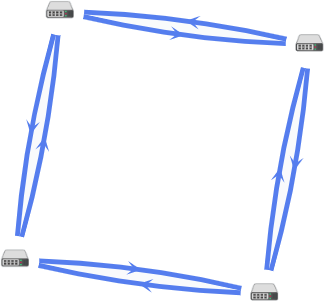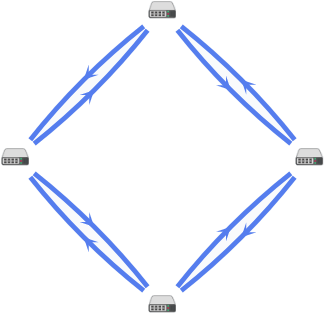Contents
Managing Point-to-Point (P2P) transport services
To display the table of P2P services, go to the Infrastructure menu section, click Management → Configuration menu next to the controller, and go to the P2P services section. Information about P2P services is displayed in the following columns of the table:
- Name is the name of the P2P service.
- Source contains information about the source service interface of the P2P service:
- Name and DPID of the CPE device on which the service interface was created
- The number of the OpenFlow port which the service interface is mapped to.
- Destination contains information about the destination service interface of the P2P service:
- Name and DPID of the CPE device on which the service interface was created
- The number of the OpenFlow port which the service interface is mapped to.
- QoS is the quality of service rule specified for the source service interface of the P2P service.
- Backup port contains information about the backup service interface of the P2P service:
- Name and DPID of the CPE device on which the service interface was created
- The number of the OpenFlow port which the service interface is mapped to.
- Status is the status of the P2P service:
- Up
- Down
The actions that you can perform with the table are described in the Managing solution component tables instructions.
Creating a P2P service
To create a P2P service:
- In the menu, go to the Infrastructure section.
This opens the resource management page. By default, the Network resources tab is selected, which displays the table of controllers.
- Click Management → Configuration menu next to the controller.
This opens the controller configuration menu. By default, you are taken to the Controller nodes section, which displays a table of controller nodes.
- Go to the P2P services section.
A table of P2P services is displayed.
- In the upper part of the page, click + P2P service.
- This opens a window; in that window, in the Name field, enter the name of the P2P service.
- In the Constraint drop-down list, select the created Manual-TE constraint or threshold constraint that you want to add to the P2P service.
- In the Balancing mode drop-down list, select the balancing mode for distributing traffic among the links:
- Per-flow means the traffic streams (5-Tuple) are distributed among the links in accordance with the link cost. Default value.
- Per-packet means the traffic packets are distributed among the links in accordance with the link cost.
- Broadcast means the traffic packets are duplicated and transmitted simultaneously through all links to avoid loss.
You can manually specify link cost.
- If necessary, in the Description field, enter a brief description of the P2P service.
- In the Switch and Port drop-down lists on the left, select the CPE device and the created service interface that you want to use as the source service interface of the P2P service.
- In the Switch and Port drop-down lists on the right, select the CPE device and the created service interface that you want to use as the destination service interface of the P2P service.
- If you want to display service interfaces that were added to transport services in the Port drop-down lists, select the Show used interfaces check box. This check box is cleared by default.
- If you want to swap the values selected in the Port drop-down lists, select the Switch interfaces check box. This check box is cleared by default.
- If you want to add a reserve service interface of the P2P service source through which traffic is transmitted if the primary service interface fails:
- Select the Use backup interface check box. This check box is cleared by default.
- In the Backup switch and Backup port drop-down lists, select the CPE device and the created service interface that you want to use as the reserve service interface.
- If you want to display service interfaces that were added to transport services in the Backup port drop-down list, select the Show used interfaces check box. This check box is cleared by default.
If the primary source service interface of the P2P service goes up again, the P2P service keeps using the backup source service interface.
- In the Inbound filter drop-down lists on the left and right, select the created traffic filter for the source and destination interfaces of the P2P service.
- In the QoS drop-down list, select the created quality of service rule for the service interface of the P2P service source.
- If you want to track the status of the source and destination service interfaces of the P2P service and when one of the interfaces goes down, automatically disable the other, select the Propagate interface status check box. This check box is cleared by default. This check box cannot be selected when the Use backup interface check box is selected.
When the service interface that was disabled first goes back online, the second service interface that was automatically disabled also resumes operation. This functionality works only on service interfaces with Access traffic classification. You can select the type of traffic classification when creating a service interface.
- Click Create.
The P2P service is created and displayed in the table.
Viewing statistics of a P2P service
To view the statistics of a P2P service:
- In the menu, go to the Infrastructure section.
This opens the resource management page. By default, the Network resources tab is selected, which displays the table of controllers.
- Click Management → Configuration menu next to the controller.
- Go to the P2P services section.
A table of P2P services is displayed.
- Click Management → Statistics next to the P2P service whose statistics you want to view.
This opens a window with statistics of the P2P service.
Page topViewing and configuring the display of a P2P service topology
To view and configure the display of a P2P service topology:
- In the menu, go to the Infrastructure section.
This opens the resource management page. By default, the Network resources tab is selected, which displays the table of controllers.
- Click Management → Configuration menu next to the controller.
This opens the controller configuration menu. By default, you are taken to the Controller nodes section, which displays a table of controller nodes.
- Go to the P2P services section.
A table of P2P services is displayed.
- Click Management → Service topology next to the P2P service whose topology you want to view.
This opens a window with the P2P service topology.
- If you need to move CPE devices, do one of the following:
- If you want to manually change the position of CPE devices, click Manual and adjust the position of CPE devices.
- If you want to automatically arrange CPE devices, click Automatically and select one of the following values from the displayed drop-down list:
- Physical simulation — CPE devices are arranged approximately in accordance with their actual location relative to each other, for example:

- Random — The arrangement of CPE devices is randomized, for example:

- Circle — CPE devices are arranged in accordance with a ring topology, for example:

- Breadthfirst — CPE devices are arranged horizontally, for example:

- Concentric — CPE devices are arranged concentrically, for example:

- Grid — CPE devices are arranged in accordance with a grid topology, for example:

- Physical simulation — CPE devices are arranged approximately in accordance with their actual location relative to each other, for example:
- If you want to display information about CPE devices, select the following check boxes:
- Name displays the names of CPE devices.
- IP address displays the IP addresses of CPE devices.
These check boxes are cleared by default.
- If you want to display a segment between two CPE devices:
- Select the Segments check box. This check box is cleared by default.
- In the displayed drop-down lists, select the source and destination CPE devices of the segment.
The segment between the CPE devices is displayed.
Editing a P2P service
To edit a P2P service:
- In the menu, go to the Infrastructure section.
This opens the resource management page. By default, the Network resources tab is selected, which displays the table of controllers.
- Click Management → Configuration menu next to the controller.
This opens the controller configuration menu. By default, you are taken to the Controller nodes section, which displays a table of controller nodes.
- Go to the P2P services section.
A table of P2P services is displayed.
- Click Management → Edit next to the P2P service that you want to edit.
- This opens a window; in that window, if necessary, edit the P2P service settings. For a description of the settings, see the instructions for creating a P2P service.
- Click Save.
The P2P service is modified and updated in the table.
Restarting a P2P service
You can restart a P2P service to restore it in case of malfunctions. When you restart a P2P service, the controller automatically deletes and re-creates the rules associated with this P2P service in the OpenFlow tables of CPE devices. This affects CPE devices whose service interfaces are added to the P2P service.
To restart a P2P service:
- In the menu, go to the Infrastructure section.
This opens the resource management page. By default, the Network resources tab is selected, which displays the table of controllers.
- Click Management → Configuration menu next to the controller.
- Go to the P2P services section.
A table of P2P services is displayed.
- Click Management → Reprovision next to the P2P service that you want to reprovision.
- In the confirmation window, click Reprovision.
The P2P service is restarted.
Page topDeleting a P2P service
Deleted P2P services cannot be restored
To delete a P2P service:
- In the menu, go to the Infrastructure section.
This opens the resource management page. By default, the Network resources tab is selected, which displays the table of controllers.
- Click Management → Configuration menu next to the controller.
- Go to the P2P services section.
A table of P2P services is displayed.
- Click Management → Delete next to the P2P service that you want to delete.
- To delete the service interfaces added to the P2P service, select the Delete associated service interfaces check box in the confirmation window. This check box is cleared by default.
- Click Delete.
The P2P service is deleted and is no longer displayed in the table.
Page top